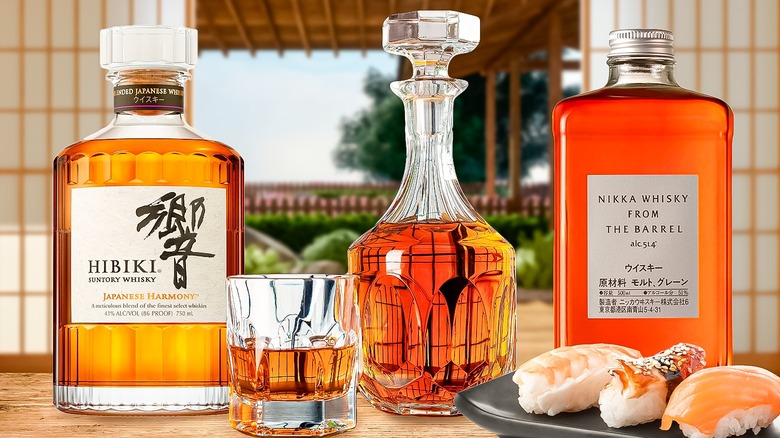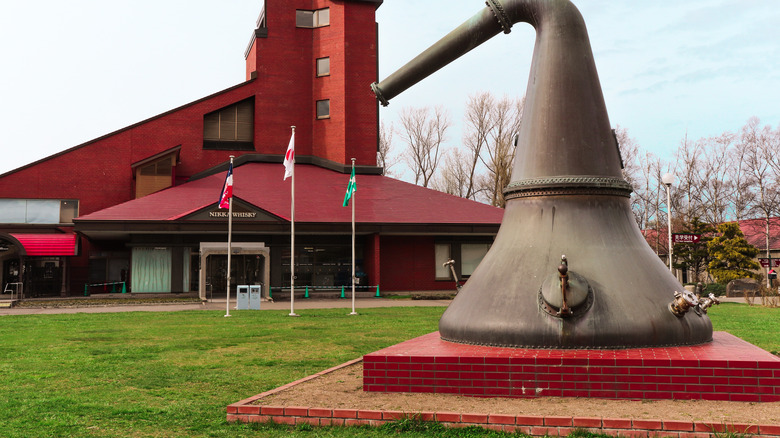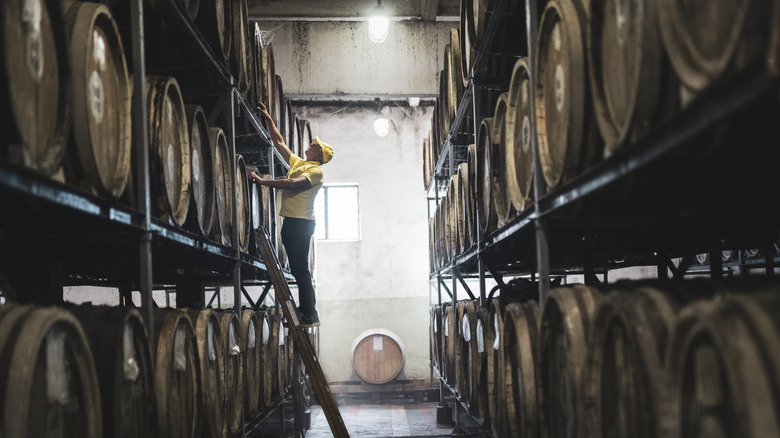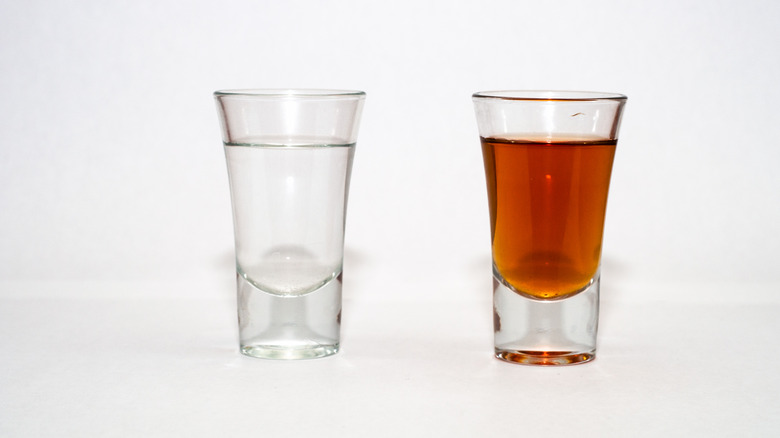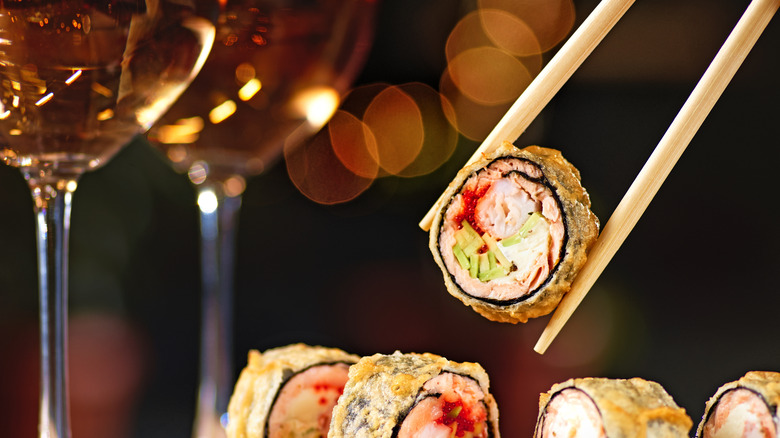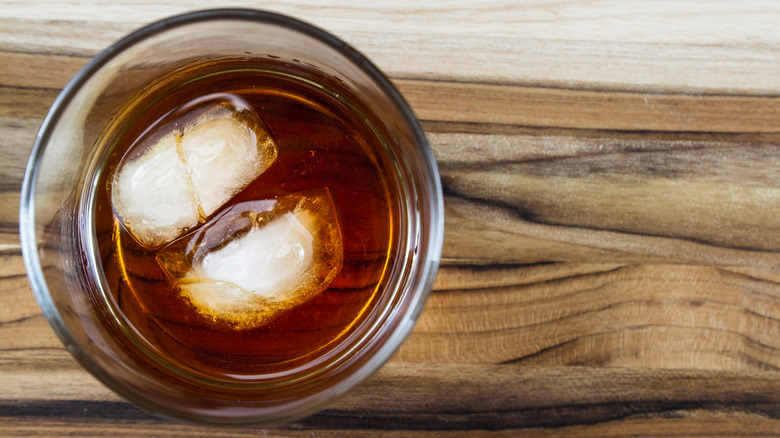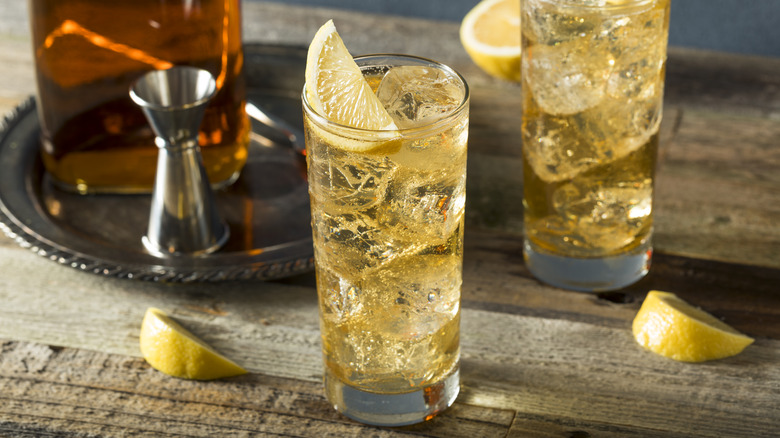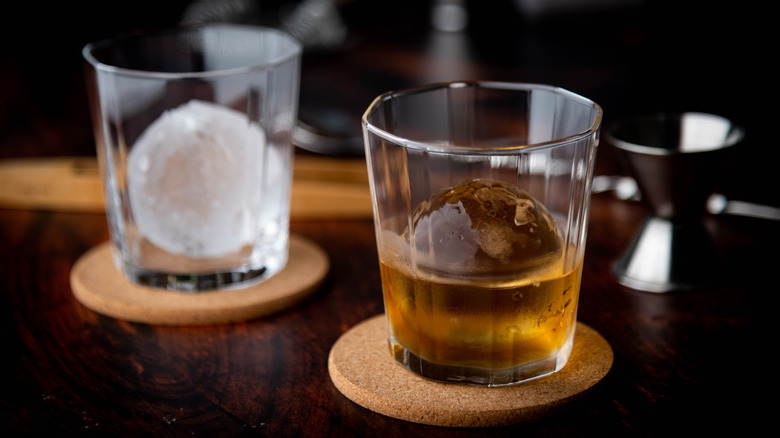10 Tips You Need To Drink Japanese Whisky The Right Way
Like prosciutto americano or wines made in Napa Valley with rootstock from France, Japanese whisky is one of those mystical foodstuffs that represents fresh eyes on an old tradition. While it'd be unfair to say there's a "wrong" way to drink Japanese whisky, there are certain techniques you can follow to do a spirit treasured for its clean, complex flavors justice.
The most common way to enjoy Japanese whisky is with (or without) water. The possible permutations of whisky and water are dizzying, and it's hard to imagine the drinking experience of each version varying greatly. Still, to the well-initiated palate, these variations are as distinct as drinking coffee black or with cream.
We sat down with Liam McNulty aka Whiskey Richard, author of Nomunication (a blog dedicated to Japan's rich cocktail tradition), and a resident of Japan to learn his tips for drinking Japanese whisky like a local. Though still in its nascency when compared to the likes of sake and shōchū, Japanese whisky has its own culture and tradition deserving of the respect given to Bourbon and Scotch. Just don't call it Japanese "Scotch."
Know its history
It'd be difficult to appreciate Japanese whisky as anything more than whisky made in Japan without understanding its origins. Despite the country's reputation for ancient food history and a devotion to traditional processing methods, many of Japan's culinary mainstays were inherited from foreign lands (soy sauce and miso originated in China). Whisky is no different: its processing techniques are borrowed from the Scotch traditions of Scotland.
It's a rather modern invention, too: According to National Geographic, Japanese whisky didn't exist until 1934, when a Japanese businessman named Masataka Taketsuru traveled to Scotland to learn how to make whisky in the Scottish tradition and brought his findings back to Japan. Taketsuru fell under the spell of the country's misty mornings, peat moss aroma, and cool climate, eventually returning to Japan to start his own distillery.
If the Scots gave birth to the beverage we call Scotch, it was the Japanese who refined it. Taketsuru knew Japan's microclimates would be well-suited to whisky-making. He founded Yoichi Distillery in Yoichi, a small town in Hokkaido, Japan. Recognizing the importance that climate had on the flavor and process of making whisky, Taketsura selected Yoichi for its proximity to several natural resources that he knew were necessary for making a distinctively Japanese whisky in the spirit of Scotch, like high humidity, cool temperatures, and neighboring forests for harvesting the wood to make barrels.
Know the houses, too
Before Yoichi Distillery started producing whisky, it made apple juice. While preparing the distillery for whisky distillation, Taketsuru used it to produce apple products, which he sold under the name "Dai Nippon Kaju" or "Great Japanese Juice Company." The distillery's first-ever whisky was eventually launched in 1940, and the company's name was eventually abbreviated to Nikka, where the prized whisky is still distilled today. Nikka Whisky now operates out of two distilleries — Miygikyo and Yoichi. Each distills several single malt varieties, two of which pay homage to each Nikka distillery. The salty sea breezes that blow in from the nearby Ishikari Bay scent the whisky with brininess, while the direct coal-fire distillation lends itself to a slightly toasty flavor that's true to Taketsuru's original vision and even more steadfast to the traditions of Scotch than many modern version still produced in Scotland.
While Taketsuru is considered the father of Japanese whisky, another equally famous house is a part of Japan's whisky tradition: The House of Suntory. Founded in 1923 by Shinjiro Torii, a pharmaceutical wholesaler who also had a hand in helping Taketsura establish the Yamasazi distillery. The House of Suntory was founded in the Yamasai area of Japan, chosen similarly to Nikka for its lush distinct climate and surrounding natural features, like soft water, that make it prime for whisky distillation. This year, the distillery celebrates its 100th anniversary — and is launching premium bottles for the occasion.
Try different styles
Japanese whisky contains much of the nuance you'd find in a Scotch or a Bourbon. To truly know what gives Japanese whisky its distinct flavor requires sampling its many varieties. Whiskies can vary by malt — the type of grain used in distillation — as well as by distillery, producer, and region. Take, for example, Nikka's Coffey Grain Japanese Whisky, which is distilled from corn, versus the brand's Coffey Malt, which relies on 100% malted barley. Flavors can range from creamy and sweet to rich and smoky. Trying different styles allows you to map out the whisky landscape so that you can easily pare down a long drink list. (Onward to true whisky mastery!)
Whisky terminology can be confusing: A single malt references whisky made from one single distillery's malt (germinated barley). When the whisky is made of different grains but in a single distillery, it is considered, confusingly, a single-grain whisky. The most premium are those that have been matured in a single cask, eponymously called "single cask." So, which do seasoned drinkers prefer? Says McNulty, "Affordable blended whiskies, of course, sell well with the general public, but dedicated whisky fans in Japan are more partial to single malts." And then there is cask strength: "While not unique to Japan, a lot of whisky fans appreciate cask strength bottlings because it provides 'raw' access to the aged spirit," says McNulty. "Since the distillery isn't adding any water when bottling the whisky, it's up to the drinker to decide how much water — if any — they want to add."
Drink it neat at least once
Drinking whisky neat may seem like something for only die-hard fans, but if you're interested in truly knowing the drink, it's worth tasting it on its own at least once. The practice is so crucial that Suntory includes a recipe for whisky and water on its website. McNulty is also a fan of whisky without any frills. "Adding no or minimal water results in a higher ABV whisky with more concentrated aromas and a different flavor profile." However, McNulty cautions against always drinking Japanese whisky this way: "This isn't always a good thing: Many whiskies need a few drops of water to reveal more depth."
The definition of "neat" varies from bartender to bartender, but most agree that neat means room temperature, whether you're adding a splash of water or not. It's best served in a rocks glass, also called a lowball glass, since aroma is an important part of the experience. At a shallow two ounces per standard pour, the shorter stature of the glass ensures your sense of smell is engaged. While "whisky neat" is a common practice for enjoying more premium spirits, any Japanese whiskies can be enjoyed this way. The goal of the first sip is to experience the complexities and nuances of the whisky so that, if and when you decide to add something else, whether that be water, seltzer, or something more flavorful, you can do so from a position of authority.
Optimize your palate
If you've chosen to drink your whisky neat, going so far as to prepare a whole flight of grains, malts, and cask strengths — good for you! But to prevent your nose and tastebuds from becoming fatigued by the booziness, you'll need to learn how to reset your palate. House of Suntory recommends preparing a "palate cleanser" (or chaser) to diffuse the deadening effects of alcohol on your sense of smell (and taste). Palate cleansers help out between sips of the same dram or between whiskies if you've prepared the flight. Resetting your nose is as simple as smelling something other than whisky — like your shirt sleeve. Rather than letting each sip run together, this small move makes each feel like the first.
As for the aftertaste, there are several strategies to diffuse the burning sensation. Try rinsing with room-temperature water. Bottled spring water or distilled works best, but if you're bar-side, non-chlorinated will do just fine. Make sure the water is at room temperature, as cold water can numb out your tastebuds. In addition to increasing your thirst, bar snacks — the blander, the better — make great palate cleansers. Try a slice of unbuttered white or sourdough bread, a few potato chips, saltine crackers, or even a few pretzels (watch out for the salt, as salt affects your palate). Drinking a light beer that's made with barley (most cheap beers are, like Stella Artois and Amstel Light) allegedly resets the palate, too.
Pair your pour with Japanese food
Taketsuru and Torii set out to craft a beverage that would complement Japan's penchant for clean, refined, and subtle flavors. Like Japanese food itself, Japanese whisky is mellow and earthy. Part of the fun of enjoying it is finding foods that pair well — dishes light enough to augment the spirit's flavor without obscuring it entirely. McNulty has found that one of his favorite Japanese dishes, kinmedai, a peculiar-looking fish that's commonly found in the waters south of Tokyo, is a perfect pairing. It's delicate and tender-fleshed, with a mild, slightly umami flavor. "My favorite way to prepare it," says McNulty, "is nitsuke: simmering it with soy sauce." Also called splendid alfonsino, the fish pairs beautifully with whiskies with "a sherry influence, or something with a hint of brine." Despite their delicate demeanor, sashimi and nigiri can — and should — be paired with bracing whisky. Choose oilier and full-flavored fish, like mackerel and prawn.
Whisky, like wine, is terroir-driven. When considering what foods to pair with it, look no further than the region in which the whisky was distilled: "Expressions from a coastal region like the islands of Scotland or the coast of Hokkaido tend to bring with them the vigorous, salty elements of their home. They, therefore, pair very well with fish and sushi in particular," advises David Wrigley of Great British Chefs. And of course, don't be shy about pairing the drink with heavier Japanese foods, like tempura, too: "Whisky has the robustness and body that can match up to fried foods in a way beer and wine certainly can't," says Wrigley.
Try it as a Mamie Taylor
Though Japanese culture is all about refinement, don't be afraid to swap this spirit in for your favorite cocktail recipes calling for Scotch. "Japanese bartenders have an immense respect for the classics. Some are so classic that U.S. drinkers may not have heard of them," says McNulty. One such drink is the Mamie Taylor, originally a Scotch-based version of the Moscow Mule. As legend would have it, the drink came about when Ms. Taylor, an opera singer in the late 19th century, went out sailing with a group of friends. When she returned with them to her hotel seeking refreshment, the bartender respected Taylor's desire for a long, not strong drink, but disregarded her request for a claret lemonade, instead serving her a Scotch-based beverage in a highball glass that looked strikingly similar to champagne. After noting she liked it and asking what it was, Sterrit smiled and, with a wink, declared the beverage "a Mamie Taylor."
"Between Prohibition and the debut of the Moscow Mule, [the drink] fell into obscurity in the United States," says McNulty, likely due to its use of Scotch over the more common American Rye and Bourbon whiskeys. The drink eventually fell out of fashion and never took off again in the States, but McNulty says the drink "has lived on in Japan since the 19th century," where Scotch-like whisky is not just the ultimate but the norm.
Serve it with mineral water
In Japan, mizuwari means "with water." Adding a splash of H20 dilutes the strength of the whisky while retaining its flavor. "The standard ratio of whisky to water is 1:2 or 2:5," says McNulty. There's not much else to the preparation: Simply fill a glass with ice, let the glass chill, add your whisky, stir well, then top with mineral water and pull the drink together with the slick stir of a bar spoon. "Twice up" is one dose of whisky for every one dose of mineral water. This is also called the "half-half," and, according to McNulty, you may find it served in Japan in a wine glass.
For a variation on a mizuwari that's technical and visually stunning, there is the whisky float. For reasons unknown to McNulty, the drink is associated with Super Nikka's blend of Coffey Whisky, a brand created to commemorate Taketsura's late wife. The float is made by pouring the denser spirit impossibly slowly over the back of a bar spoon until the whisky reaches a small pour of whisky and appears to "float" on the water's surface. McNulty suspects the drink was a marketing ploy on behalf of Nikka to compete with Suntory, but the drink still has merit: "The whisky float's selling point is that you can transition from straight whisky, to on the rocks, to with water, at whatever pace you like. It's only a matter of tilting the glass more or less."
Try it as a highball
Though not quite beer, the barley-based highball is one of the most "sessionable" whisky drinks. "While not originally from Japan, one could easily argue that the whisky highball renaissance we're experiencing today is because of the country," says McNulty. In Japan, highballs are treated with ritualistic attention to detail: The ice may be hand-cut, and the soda poured long and slow. According to the House of Suntory, the real key to making a great drink is not to over-stir it, which has a dampening effect on its bubbles.
In Japan, it's not considered gauche to serve a highball without ice. The Samboa highball (formerly the Kobe highball and later, the Rockfish Ginza, all named after the Japanese bars where they originated) does not contain ice at all — only sparkling water and a twist of lemon or grapefruit. This preparation prevents the chill of the ice cubes from dulling your tastebuds. Since no ice is used, both whisky and glass are pulled straight from the freezer, lest the drink taste flat. One of the more obscure ways to drink whisky and water is a technique called choiso, short for "chotto soda wari," or "with a little bit of water." "Of course," says McNulty, "your first question is, how much is a little bit?" While there may be no conclusive answer, McNulty believes you pour until the ice in your lowball glass reaches the rim.
Experience the whisky ice ball
The Japanese have come up with a solution to the watered-down cocktail that's as aesthetically pleasing as it is functional: the ice ball. According to McNulty, to prevent excessive dilution while ensuring maximum chilling, Japanese bartenders will buy ice in giant blocks from vendors and split it into manageable cubes before chipping it down, by hand, into nature's most perfect shape: a sphere.
To ensure a snug fit even in tumblers with flared bottoms, the sphere is carved "just barely too big for the glass." The room-temperature whisky is then poured over the ice ball and given a stir. "Pouring whisky atop the ice ball and then giving it a few twirls with a bar spoon allows it to finally reach the bottom of the glass." This preparation style requires an astounding level of precision and patience to execute well: "Since many bars have a variety of tumblers in different shapes and many bartenders will carve the ice ball per order." For a slightly less elegant but far simpler variation, there is the Mist, which uses crushed ice instead of a sphere, like Mint Julep and Whisky Smash.
